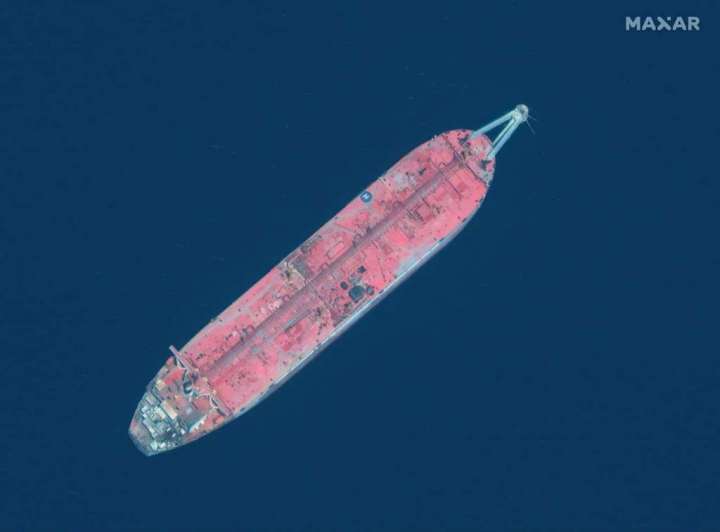The United Nations has turned to crowdfunding to raise the $80 million needed to remove more than a million barrels of oil from a decaying tanker in the Red Sea and prevent a potential environmental catastrophe.
U.N. turns to crowdfunding to salvage oil tanker decaying off Yemen

Seawater has already seeped into the engine room, according to U.N. officials who are sounding the alarm that a tank rupture or explosion would wreak havoc on marine life, vital shipping lanes and regional economies.
For years, the United Nations has sought to launch a rescue mission to transfer the oil and move the ship to a safer location for inspections or dismantling. But the vessel is anchored in waters northwest of Yemen’s port city of Hodeida near territory held by the Iranian-aligned Houthi rebels. The war between them and the now-Saudi-backed government had put an end to maintenance and prevented any offloading.
The opposing sides have finally agreed to a plan to prevent a disaster, the United Nations said, but now it doesn’t have the money to implement it.
“The tanker is beyond repair, and the fear is that it could soon break apart or explode,” the global body said this week as it launched the online crowdfunding campaign.
The U.N. announcement said it collected about three-quarters of the money necessary to transfer the oil to another ship, after Saudi Arabia and the United States recently promised $10 million each, following pledges from the Netherlands, France, Qatar and others that brought the total in U.N. hands to $60 million.
To help pay the remaining $20 million, the United Nations’ Yemen coordinator, David Gressly, is appealing online to people everywhere to raise $5 million by the end of the month so that work can start in July.
At a briefing on Monday, Gressly appeared to acknowledge that the call for $5 million from the public was unusual, describing it as “an ambitious goal,” but maintained that a disaster was looming. The increase of currents and winds in the winter will heighten the risk of the vessel breaking up and spilling the oil into the Red Sea.
“Every day that goes by is another day that we take a risk, a chance that this vessel will break up and the catastrophe that I described will unfold,” he said.
The entire plan, involving first unloading the oil and later replacing the 1,230-foot vessel — one of the world’s largest tankers — would cost $144 million, according to U.N. estimates.
A disaster in the Red Sea would add to the plight of Yemenis who have endured nearly eight years of war, starvation and disease, and threaten the livelihoods of many who rely on the sea’s resources. Gressly said it may take up to 25 years to restock fisheries.
U.N. officials and conservationists say an oil spill from the Safer would destroy the ecosystems of the Red Sea, an important biodiversity sphere, and take decades and at least $20 billion to clean up.
“An oil spill of the anticipated magnitude at this location would suddenly interrupt critical aid supplies by closing nearby ports, thereby stopping essential shipments of food, fuel and medicine,” said Richard Carter, director of the Coastal Coordination Program at The Ocean Foundation in Washington, D.C.
He said it made sense to look for external financing in the case of an “orphaned” vessel, where ownership and liability might be unclear, after Washington urged private companies that use the Red Sea for commercial activity to also help fund the U.N. project.
The U.S. special envoy for Yemen, Tim Lenderking, told reporters that the Houthis had agreed with U.N. officials on offloading the oil, whereas talks about what happens to the oil and how to tow the vessel away would take place later.
Under the memorandum of understanding, signed in March, a short-term solution would move the oil from the Safer to another ship. But the agreement is contingent on mobilizing donor funds.
The Houthis — who have been accused of holding up the emergency operation in the past — have repeatedly called on the United Nations to present the operational plan stipulated in the memorandum and accused it of “procrastinating in taking practical and technical steps to start maintaining the Safer reservoir.”
Calling the Safer “a ticking time bomb,” Lenderking said it could take just “a cigarette butt, the discharge of a weapon, [or] a rough wave” to cause a spill, and he said the supertanker also risked exploding.
A study commissioned by the United Nations in recent years found that a spill or blast could hike fuel and food prices, cause crop losses and contaminate thousands of water wells. It would kill marine mammals, sea turtles and seabirds, destroy pristine coral reefs, and slash hundreds of thousands of jobs in the fishing industry.
If the vessel sinks, explodes or spills its cargo, the consequences would be catastrophic, Carter said.
“Millions of people would be exposed to highly-polluted air, desperate aid-dependent citizens would be deprived of supplies needed for their survival and the marine environment over a large region would unnecessarily become a tragic casualty of war,” he said.
Ali Al-Mujahed in Sanaa, Yemen contributed to this report.






